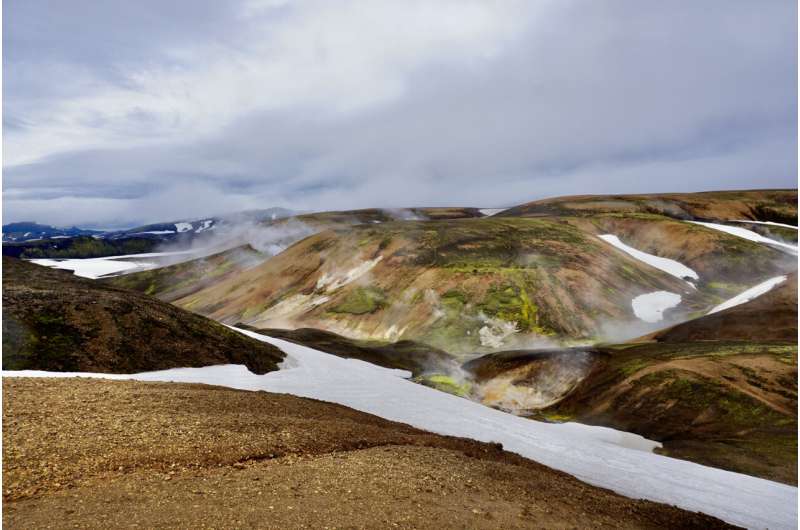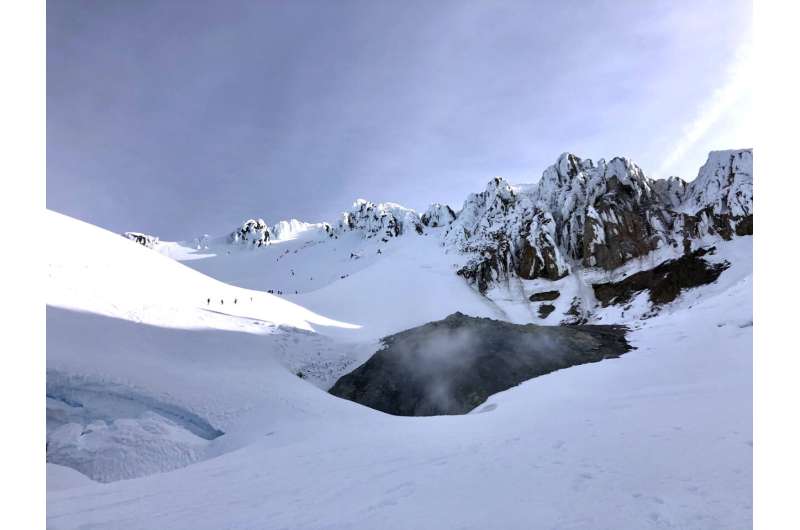Ice cores show even dormant volcanoes leak abundant sulfur into the atmosphere

Volcanoes draw plenty of attention when they erupt. But new research led by the University of Washington shows that volcanoes leak a surprisingly high amount of their atmosphere- and climate-changing gases in their quiet phases. A Greenland ice core shows that volcanoes quietly release at least three times as much sulfur into the Arctic atmosphere than estimated by current climate models.
The study, led by the University of Washington and published Jan. 2 in Geophysical Research Letters, has implications for better understanding Earth’s atmosphere and its relationship with climate and air quality.
“We found that on longer timescales the amount of sulfate aerosols released during passive degassing is much higher than during eruptions,” said first author Ursula Jongebloed, a UW doctoral student in atmospheric sciences. “Passive degassing releases at least 10 times more sulfur into the atmosphere, on decadal timescales, than eruptions, and it could be as much as 30 times more.”
The international team analyzed layers of an ice core from central Greenland to calculate levels of sulfate aerosols between the years 1200 and 1850. The authors wanted to look at the sulfur emitted by marine phytoplankton, which were previously believed to be the biggest source of atmospheric sulfate in pre-industrial times.
“We don’t know what the natural, pristine atmosphere looks like, in terms of aerosols,” said senior author Becky Alexander, a UW professor of atmospheric sciences. “Knowing that is a first step to better understanding how humans have influenced our atmosphere.”
The team deliberately avoided any major volcanic eruptions and focused on the pre-industrial period, when it’s easier to distinguish the volcanic and marine sources.
“We were planning to calculate the amount of sulfate coming out of volcanoes, subtract it and move on to study marine phytoplankton,” Jongebloed said. “But when I first calculated the amount from volcanoes, we decided that we needed to stop and address that.”
The location of the ice core at the center of the Greenland Ice Sheet records emissions from sources over a wide swath of North America, Europe and surrounding oceans. While this result applies only to geologic sources within that area, including volcanoes in Iceland, the authors expect it would apply elsewhere.

“Our results suggest that volcanoes, even in the absence of major eruptions, are twice as important as marine phytoplankton,” Jongebloed said.
The discovery that non-erupting volcanoes leak sulfur at up to 3 times the rate previously believed is important for efforts to model past, present and future climate. Aerosol particles, whether from volcanoes, vehicle tailpipes or factory chimneys, block some solar energy. If the natural levels of aerosols are higher, that means the rise and fall of human emissions—peaking with the acid rain of the 1970s and then dropping with the Clean Air Act and increasingly strict air quality standards—have had less of an effect on temperature than previously believed.
“There’s sort of a ‘diminishing returns’ effect of sulfate aerosols, the more that you have, the less the effect of additional sulfates,” Jongebloed said. “When we increase volcanic emissions, which increases the baseline of sulfate aerosols, we decrease the effect that the human-made aerosols have on the climate by up to a factor of two.”
That means Arctic warming in recent decades is showing more the full effects of rising heat-trapping greenhouse gases, which is by far the main control on Earth’s average temperature.
“It’s not good news or bad news for climate,” Jongebloed said of the result. “But if we want to understand how much the climate will warm in the future, it helps to have better estimates for aerosols.”
Better estimates for aerosols can improve global climate models.
“We think that the missing emissions from volcanoes are from hydrogen sulfide,” said Alexander, referring to the gas that smells like rotten eggs. “We think that the best ways to improve these estimates of volcanic emissions is to really think about the hydrogen sulfide emissions.”
More information:
U. A. Jongebloed et al, Underestimated Passive Volcanic Sulfur Degassing Implies Overestimated Anthropogenic Aerosol Forcing, Geophysical Research Letters (2023). DOI: 10.1029/2022GL102061
Citation:
Ice cores show even dormant volcanoes leak abundant sulfur into the atmosphere (2023, February 3)
retrieved 3 February 2023
from https://phys.org/news/2023-02-ice-cores-dormant-volcanoes-leak.html
This document is subject to copyright. Apart from any fair dealing for the purpose of private study or research, no
part may be reproduced without the written permission. The content is provided for information purposes only.
For all the latest Science News Click Here
For the latest news and updates, follow us on Google News.

